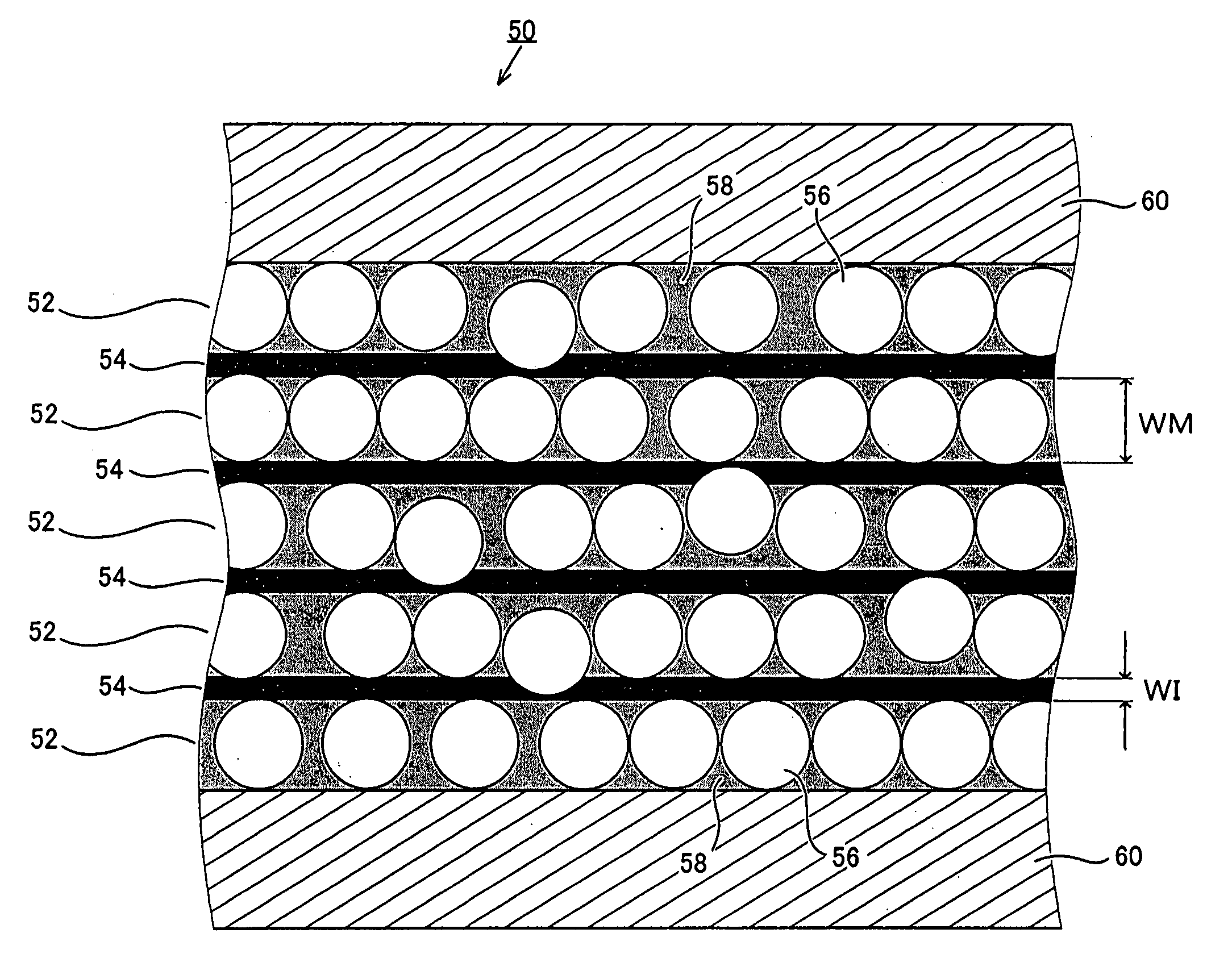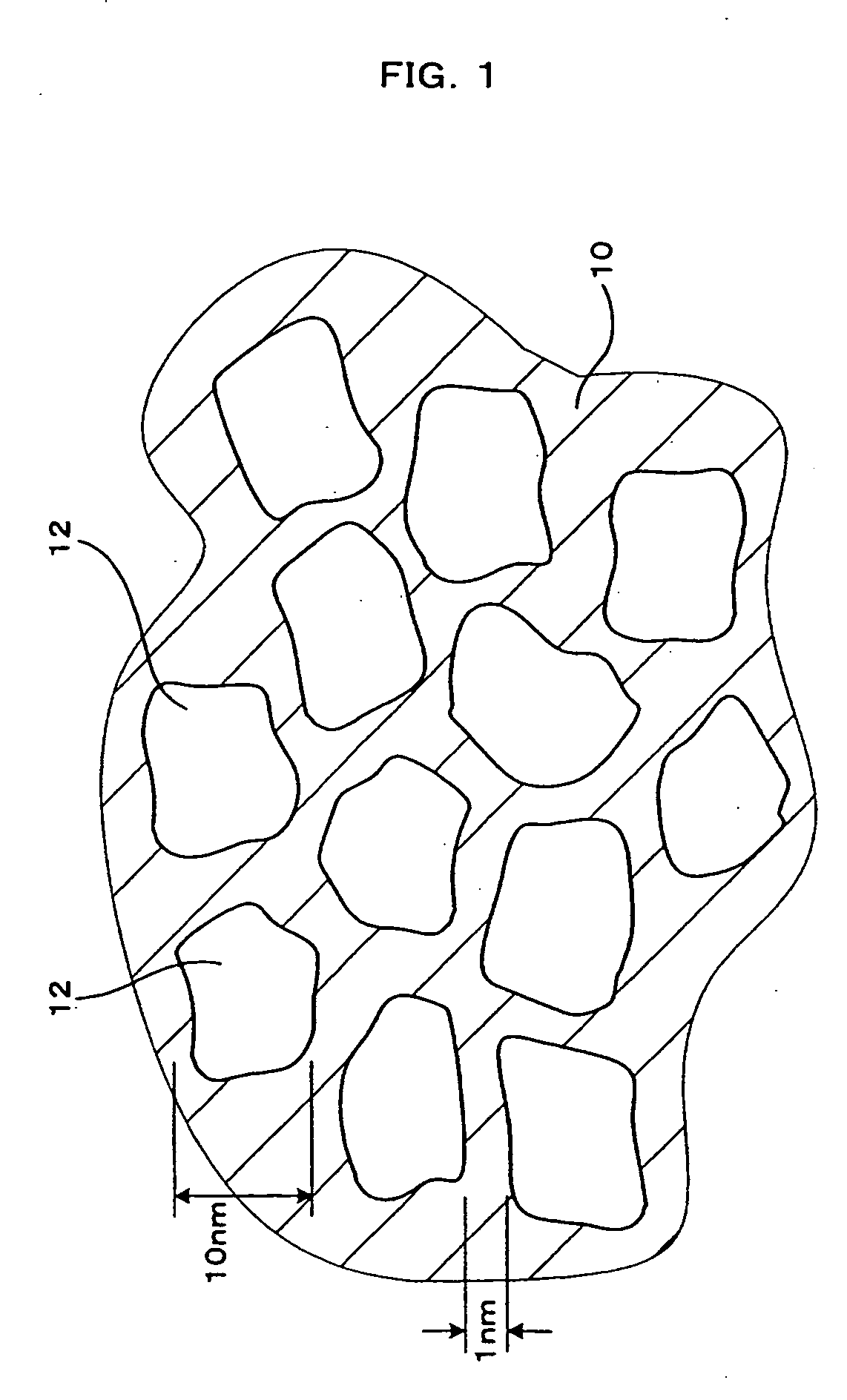Granular magnetic thin film and method for making the same, multilayered magnetic film, magnetic components and electronic equipment
a thin film, multi-layered technology, applied in the direction of ultrathin/granular films, magnetic bodies, instruments, etc., can solve the problems of limiting the operating band, deteriorating the soft magnetic properties, deteriorating the resistivity, etc., to achieve easy film formation, reduce the number of parameters for film forming conditions, increase saturation magnetization
- Summary
- Abstract
- Description
- Claims
- Application Information
AI Technical Summary
Benefits of technology
Problems solved by technology
Method used
Image
Examples
embodiment 2
[0050] Next, Embodiment 2 will be described. This embodiment is one directed to a thin film inductor produced by mounting the previously mentioned nano-granular magnetic thin film. FIG. 5 shows its perspective view and the principal parts of the device are shown in section. In the Figure, a polyimide insulating layer 22 is first applied to the thickness of 7 .mu.m to the principal surface of an Si substrate 20 of 400 .mu.m in thickness by a suitable method such as a spin coater. Then, a magnetic thin film 24 of CoFeAlO according to the previously mentioned Embodiment 1 is formed to the thickness of 0.5 .mu.m on the insulating layer 22 by the combination of a multi-target simultaneous sputtering and a nonreactive sputtering. A protective film (passivation film) 26 of Al.sub.2O.sub.3 is formed to the thickness of 0.1 .mu.m on the magnetic thin film 24 by a suitable method such as sputtering. A polyimide insulating layer 28 is again formed to the thickness of 7 .mu.m on the protective ...
embodiment 3
[0054] Embodiment 3 will now be described. Embodiment 3 is one of more preferred forms of Embodiment 2 such that oxidation preventive films 23 and 25 are provided on the top and back surfaces of the magnetic thin film 24 as shown in FIG. 7. As mentioned previously, the present invention features that the magnetic metal of the magnetic thin film 24 is nonoxidizable. However, if the vacuum is ruined after the formation of the magnetic thin film 24, the magnetic metal of the magnetic thin film 24 combines with the oxygen and moisture in the air and it is oxidized, thus lowering the saturation magnetization and thereby deteriorating the magnetic properties as a whole. Conducting a treatment tending to heat the magnetic thin film 24 has the effect of advancing the oxidation of the magnetic metal.
[0055] Thus, in accordance with the present embodiment, the magnetic metal in the magnetic thin film 24 is prevented from being oxidized by forming the oxidation preventive films 23 and 25 on the...
embodiment 4
[0057] Next, Embodiment 4 of the present invention will be described. While the above-mentioned Embodiments 1 to 3 have been described as applied to the granular magnetic thin film of the single layer structure, the present embodiment will be described as applied to a multilayered magnetic film formed by laminating magnetic layers and insulating layers (the same applies to the below-mentioned embodiments). The basic construction of the multilayered magnetic film of the present embodiment will be described first with reference to FIG. 8.
[0058] FIG. 8 is a principal sectional view of a multilayered magnetic film or multilayered granular film 50. As shown in the Figure, the multilayered magnetic film 50 has a multilayered structure formed by alternately laminating a plurality of magnetic layers 52 each composed of a granular thin film in which an insulating material 58 and nonoxidizable-metal magnetic grains (nonoxidizable magnetic grains) 56 are separately coexist and insulating layer...
PUM
| Property | Measurement | Unit |
|---|---|---|
| thickness | aaaaa | aaaaa |
| thickness | aaaaa | aaaaa |
| thickness | aaaaa | aaaaa |
Abstract
Description
Claims
Application Information
 Login to View More
Login to View More - R&D
- Intellectual Property
- Life Sciences
- Materials
- Tech Scout
- Unparalleled Data Quality
- Higher Quality Content
- 60% Fewer Hallucinations
Browse by: Latest US Patents, China's latest patents, Technical Efficacy Thesaurus, Application Domain, Technology Topic, Popular Technical Reports.
© 2025 PatSnap. All rights reserved.Legal|Privacy policy|Modern Slavery Act Transparency Statement|Sitemap|About US| Contact US: help@patsnap.com



